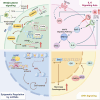Immunotherapy targeting liver cancer tumor-initiating cells: challenges, mechanisms, and emerging therapeutic horizons
- PMID: 40568600
- PMCID: PMC12187837
- DOI: 10.3389/fimmu.2025.1621243
Immunotherapy targeting liver cancer tumor-initiating cells: challenges, mechanisms, and emerging therapeutic horizons
Abstract
Liver cancer is a major global health burden, with hepatocellular carcinoma (HCC) being the most common type. Liver cancer tumor-initiating cells (TICs) are responsible for recurrence, metastasis, and therapeutic resistance, thereby presenting formidable treatment challenges. This review provides a comprehensive summary of the biological features of liver cancer TICs, including their potential cellular origins, diagnostic difficulties, key signaling pathways, and complex interactions with the tumor immune microenvironment. Special emphasis is placed on immunotherapeutic strategies, which have shown notable progress but remain limited by TIC-induced immune resistance. The review discusses current approaches such as immune checkpoint inhibitors (ICIs), adoptive cell therapies, and tumor vaccines, as well as combination strategies integrating immunotherapy with chemotherapy, targeted therapy, and locoregional interventions. Furthermore, emerging strategies including gene editing, targeted tyrosine kinase inhibition, and artificial intelligence-based tumor prediction are being explored for their potential to improve therapeutic efficacy. The significance of this review lies in highlighting the importance of surmounting the challenges presented by TICs to boost the efficacy of liver cancer treatment. In conclusion, although existing treatment approaches have demonstrated promise, further research is warranted to elucidate the origins of TICs, establish accurate diagnostic methods, and overcome resistance, ultimately enhancing the efficacy of liver cancer treatment and improving patient outcomes.
Keywords: genome editing; immunotherapy; liver cancer; nanotechnology; non-coding RNAs; therapeutic resistance; tumor microenvironment; tumor-initiating cells.
Copyright © 2025 Chai, Xu, Chen, Chen, Du and Zhang.
Conflict of interest statement
The authors declare that the research was conducted in the absence of any commercial or financial relationships that could be construed as a potential conflict of interest.
Figures

Similar articles
-
The immunomodulatory role of tumor-initiating cells in digestive system tumors: from mechanisms to therapy.Front Immunol. 2025 Jul 24;16:1621464. doi: 10.3389/fimmu.2025.1621464. eCollection 2025. Front Immunol. 2025. PMID: 40777043 Free PMC article. Review.
-
Noninvasive prediction of the clinical benefit of immunotherapy in hepatocellular carcinoma.J Gastroenterol. 2025 Sep;60(9):1053-1069. doi: 10.1007/s00535-025-02251-x. Epub 2025 May 30. J Gastroenterol. 2025. PMID: 40447887 Free PMC article. Review.
-
Targeting tumor-associated macrophages to overcome immune checkpoint inhibitor resistance in hepatocellular carcinoma.J Exp Clin Cancer Res. 2025 Aug 5;44(1):227. doi: 10.1186/s13046-025-03490-9. J Exp Clin Cancer Res. 2025. PMID: 40764998 Free PMC article. Review.
-
Immunotherapy in microsatellite-stable colorectal cancer: Strategies to overcome resistance.Crit Rev Oncol Hematol. 2025 Aug;212:104775. doi: 10.1016/j.critrevonc.2025.104775. Epub 2025 May 21. Crit Rev Oncol Hematol. 2025. PMID: 40409481 Review.
-
NK cell-based immunotherapy in hepatocellular carcinoma: An attractive therapeutic option for the next decade.Cell Signal. 2024 Dec;124:111405. doi: 10.1016/j.cellsig.2024.111405. Epub 2024 Sep 12. Cell Signal. 2024. PMID: 39260532 Review.
References
Publication types
MeSH terms
Substances
LinkOut - more resources
Full Text Sources
Medical

